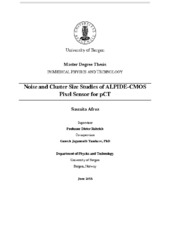Noise and Cluster Size Studies of ALPIDE-CMOS Pixel Sensor for pCT
Master thesis
Permanent lenke
https://hdl.handle.net/1956/18057Utgivelsesdato
2018-07-04Metadata
Vis full innførselSamlinger
Sammendrag
The use of proton beam has been introduced in medical physics for therapeutic purposes in cancer treatment and it has been proven much more efficient than conventional X-ray. Treatment planning in proton therapy is usually provided with information from X-ray CT where X-ray attenuation in tissue is needed to be converted to proton stopping power. This conversion leads to several uncertainties because proton interacts with matter in a different way than the photon. An intuitive way to mitigate this problem is using charged particles as the basis for the CT-scan and this is the time when the idea of “Proton CT” came up. There are nearly 10 pCT prototypes worldwide and all are designed with two separate devices for proton tracking and calorimetry. Few recent studies discovered the potential of merging these two separate systems into one uniquely featured Digital Tracking Calorimeter (DTC). The DTC is made of multiple layers of Monolithic Active Pixel Sensor (MAPS) chips. In this study, ALPIDE chip has been brought in as MAPS for DTC. The ALPIDE was developed for the heavy-ion experiment at CERN to detect high energy charged particles. For pCT, ALPIDE is conceptually an ideal sensor because of its low power consumption and chip area with more than half a million pixels with in-pixel readout scheme. This thesis is carried out in three main parts: • Characterization of ALPIDE chip focusing particularly on chip’s threshold and fake hit rate. • Measuring radiation-induced effects on the sensor performance. • Analysing sensor response for different types of radiation. In addition, I contributed to Proton Beam Test at OCL, Oslo and analyzed the data afterward. This thesis also includes the analysis performed on proton beam data and significant findings from the analysis. This study represents a key contribution to pCT in terms of defining the sensor behavior and interpreting sensor response.
